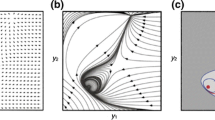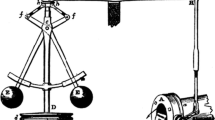Abstract
Proponents of mechanistic explanations have recently proclaimed that all explanations in the neurosciences appeal to mechanisms. The purpose of the paper is to critically assess this statement and to develop an integrative account that connects a large range of both mechanistic and dynamical explanations. I develop and defend four theses about the relationship between dynamical and mechanistic explanations: that dynamical explanations are structurally grounded, that they are multiply realizable, possess realizing mechanisms and provide a powerful top-down heuristic. Four examples shall support my points: the harmonic oscillator, the Haken–Kelso–Bunz model of bimanual coordination, the Watt governor and the Gierer–Meinhardt model of biological pattern formation. I also develop the picture of “horizontal” and “vertical” directions of explanations to illustrate the different perspectives of the dynamical and mechanistic approach as well as their potential integration by means of intersection points.
Similar content being viewed by others
Notes
As a reviewer has pointed out, the assumption that generalizability and scope are explanatory virtues is already controversial and should particularly be argued for. While a general discussion of the nature of scientific explanation is beyond the scope of the present paper, I like to add this much: explanation raises understanding, hence, an explanatory pattern with a wider scope raises a bigger understanding than with a narrow scope. So far, I take sides with the basic idea of unificationism. I do, on the other hand, agree that many of the well-known standard problems of the classic DN- and unificationist approach stem from the fact that causation has not suitably been taken into account. The purpose of the present approach (and the present section in particular) is to present an integrated picture of a “horizontal” and a “vertical” direction of explanation and to eventually stress the idea that a full-fledged understanding of many phenomena is only brought forth once we understand their particular mechanistic realizations as well as their deep and generalizable structural core. In this respect, the present approach is in general harmony with a recent paper by Bangu (2017) who presents a revised unificationist account that aims to incorporate the causal account as a sub-component.
Of course, as Bechtel (2009) for instance discusses, the possibility of conservation of mechanisms through evolutionary descent allows for a certain, limited generalization of mechanistic explanations.
Note that what is ‘predicted’ here is the existence of a mechanism of a certain type (the GM type, i.e. with a structural core represented by the GM model equations). For instance, to take a most recent research result, the particular GM-type mechanism responsible for the color and pattern of skin scales in lizards (Manukyan et al. 2017). The prediction of mechanism types serves as a research heuristics and should of course not be conflated with the prediction of the temporal evolution of a certain system (e.g. by means of its underlying dynamical equations). To consider prediction in this latter sense as already explanatory is highly controversial (and of course dismissed by most mechanists). But it should be clear that this is a different sense of prediction than what I have in mind here.
References
Bangu, S. (2017). Scientific explanation and understanding: Unificationism reconsidered. European Journal for Philosophy of Science, 7(1), 103–126.
Bechtel, W. (2009). Generalization and discovery by assuming conserved mechanisms: Cross-species research on circadian oscillators. Philosophy of Science, 76, 762–773.
Bechtel, W., & Abrahamsen, A. (2005). Explanation: A mechanist alternative. Studies in History and Philosophy of Biology and Biomedical Sciences, 36(2), 421–441.
Bechtel, W., & Abrahamsen, A. (2010). Dynamic mechanistic explanation: Computational modeling of circadian rhythms as an exemplar for cognitive science. Studies in History and Philosophy of Science, 41, 321–333.
Brauer, F., & Kribs, C. (2016). Dynamical systems for biological modeling: An introduction. Boca Raton, FL: CRC Press.
Chemero, A., & Silberstein, M. (2008). After the philosophy of mind: Replacing scholasticism with science. Philosophy of Science, 75, 1–27.
Craver, C. (2007). Explaining the brain: Mechanisms and the mosaic unity of neuroscience. Oxford: Oxford University Press.
Craver, C. & Kaplan, D. M. (2011). Towards a mechanistic philosophy of neuroscience: A Mechanistic Approach. In: S. French, & J. Saatsi (eds.) The continuum companion to the philosophy of science, Continuum.
Dizadji-Bahmani, F., Frigg, R., & Hartmann, S. (2010). Who’s afraid of Nagelian reduction? Erkenntnis, 73, 393–412.
Eigen, M. (1971). Selforganization of matter and the evolution of biological macromolecules. Die Naturwissenschaften, 58(10), 465–523.
Felline, L. (2015). Mechanisms meet structural explanation. Synthese. https://doi.org/10.1007/s11229-015-0746-9.
Gerstner, W., Kistler, W. M., Naud, R., & Paninski, L. (2014). Neuronal dynamics. From single neurons to networks and models of cognition. Cambridge: Cambridge University Press.
Gierer, A., & Meinhardt, H. (1972). A theory of biological pattern formation. Kybernetik, 12, 30–39.
Haken, H., Kelso, J. A. S., & Bunz, H. (1985). A theoretical model of phase transitions in human hand movements. Biological Cybernetics, 51, 347–356.
Izhikevich, E. M. (2007). Dynamical systems in neuroscience: The geometry of excitability and bursting. Cambridge, MA: MIT Press.
Kaplan, D. M. (2011). Explanation and description in computational neuroscience. Synthese, 183, 339–373.
Kaplan, D. M. (2015). Moving parts: The natural alliance between dynamical and mechanistic modeling approaches. Biology and Philosophy, 30, 757–786.
Kaplan, D. M., & Craver, C. F. (2011). The explanatory force of dynamical and mathematical models in neuroscience: A mechanistic perspective. Philosophy of Science, 78, 601–627.
Kuhlmann, M. (2014). Explaining financial markets in terms of complex systems. Philosophy of Science, 81, 1117–1130.
Levy, A., & Bechtel, W. (2013). Abstraction and the organization of mechanisms. Philosophy of Science, 80(2), 241–261.
Lyre, H. (2009). The “Multirealization” of multiple realizability. In A. Hieke & H. Leitgeb (Eds.), Reduction–abstraction–analysis (pp. 79–94). Frankfurt: Ontos.
Machamer, P. K., Darden, L., & Craver, C. F. (2000). Thinking about mechanisms. Philosophy of Science, 67(1), 1–25.
Meinhardt, H. (1982). Models of biological pattern formation. London: Academic Press.
Manukyan, L., Montandon, S. A., Fofonjka, A., Smirnov, S., & Milinkovitch, M. C. (2017). A living mesoscopic cellular automaton made of skin scales. Nature, 544, 173–179.
Ross, L. N. (2015). Dynamical models and explanation in neuroscience. Philosophy of Science, 81(1), 32–54.
Schöner, G., & Kelso, S. (1988). Dynamic pattern generation in behavioral and neural systems. Science, 239, 1513–1520.
Schuster, P. (2011). Physical principles of evolution. In H. Meyer-Ortmanns & S. Thurner (Eds.), Principles of evolution. Berlin: Springer.
Stepp, N., Chemero, A., & Turvey, M. T. (2011). Philosophy for the rest of cognitive science. Topics in Cognitive Science, 3, 425–437.
Zednik, C. (2011). The nature of dynamical explanation. Philosophy of Science, 78, 238–263.
Acknowledgements
Many thanks to Carlos Zednik and two anonymous reviewers for valuable inputs and comments that helped to improve the paper.
Author information
Authors and Affiliations
Corresponding author
Rights and permissions
About this article
Cite this article
Lyre, H. Structures, dynamics and mechanisms in neuroscience: an integrative account. Synthese 195, 5141–5158 (2018). https://doi.org/10.1007/s11229-017-1616-4
Received:
Accepted:
Published:
Issue Date:
DOI: https://doi.org/10.1007/s11229-017-1616-4




